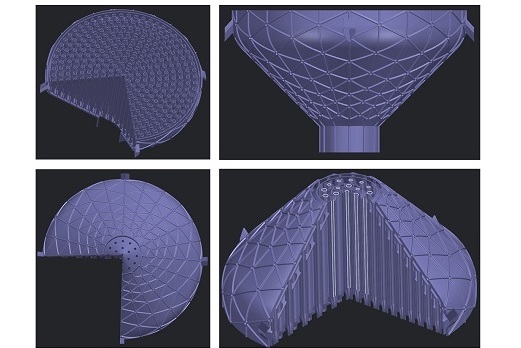The 3D Printing Industry Awards 2022 shortlists are now available for voting. Who will win the 2022 3DPI Awards? Have your say by casting your vote now.
GE’s industrial 3D printing division GE Additive has partnered with oil and gas multinational Shell to develop a unique oxygen hydrogen micromixer demonstrator.
Also known as hydrogen-oxygen burners, such parts are often used in furnaces designed to efficiently melt metal scrap, or within industrial, refinery or energy-generating turbines. Produced from nickel alloy 718 using a Concept Laser M Line 3D printer, the model was only initially developed as a prototype, but with GE working on many turbine R&D projects, something similar could one day find end-usage.
“We really wanted to put the M Line through its paces and test it to its limits,” explained Joost Kroon, an additive technology subject matter expert at Shell. “Working with the GE Additive team we agreed to apply additive technology to reimagine a large, complex part, incorporating channels that would be difficult to manufacture conventionally.”
“Working on an oxygen hydrogen micromixer aligns well with our companies’ strategies to play a positive role in the energy transition.”

R&D at GE Additive’s ATC
Operating as a business unit of US energy multinational GE, GE Additive specializes in the design and manufacture of parts that harness the potential of metal 3D printing. Much of this work happens at GE’s Additive Technology Center (ATC) in Cincinnati, as well as the newer GE Additive facility nearby, where the design of both parts and the firm’s own technologies are optimized ahead of production.
One of the highest-profile parts to have been developed at the facilities is GE’s 3D printed fuel nozzle tip. Designed to be 25% lighter and 15% more fuel efficient than CFM56 alternatives, the part has become something of a poster child for 3D printing in the aerospace industry, and it has now been manufactured over 140,000 times.
Over the last decade, GE has built out its 3D printing capabilities via the acquisitions of Morris Technologies, Arcam and Concept Laser. The firm not only continues to market these machines, but use them to develop further aerospace parts. These have found applications in the GE90, GE9X and Catalyst engines, as well as the LEAP engines of CFM International, a joint GE-Safran Aircraft Engines venture.
As revealed during 3D Printing Industry’s recent tour of the ATC, GE’s technologies are now gaining traction in defense, and it’s working with the US Army to develop a replacement for the GE T901 engine. To expand its commercial offering, the company has also launched the Series 3 Binder Jet 3D printer, a platform designed to enable the production of huge metal parts like castings on an industrial scale.

A 3D printing-enhanced micromixer
Shell and GE Additive’s micromixer prototype has been developed as part of a joint design and engineering project, set up to push the M Line to the absolute limit. From the outset, GE Additive engineer Sonali Sonawane was tasked with researching, designing and iterating upon the part’s design, ahead of its manufacture and display at this year’s Formnext trade show.
Specifically, Sonawane’s brief was to come up with a large, complex part featuring channels for hydrogen and compressed oxygen to pass through. Once she and her colleagues in GE Additive’s AddWorks team had settled on an oxygen hydrogen micromixer, they found they were able to leverage the design freedoms provided by 3D printing, to develop a part with structurally-enhanced resistance properties.
“Our preliminary research showed that existing micromixers are typically cylindrical, when conventionally manufactured, to accommodate the complex layout of tanks, pipes and nozzles,” explained Sonawane. “For additional complexity we chose a large conical design and also moved from a flat to a curved structure with an ISO grid to increase the overall strength, rather than a customary flat one.”
Incorporating over 330 individual nozzles in a circular pattern, the resulting part was built around a pattern resembling that of the Fibonnaci sequence, only replicated in flowers and petals. Measuring 296 mm in height and 484 mm in diameter, the large-format build was post-processed (and has since been put on display at) Shell’s Energy Transition Campus Amsterdam (ETCA) in the Netherlands.
Though nominally developed as a prototype, the micromixer could also have applications within GE’s wider energy business. As recently as October 2022, GE gained $6.6 million in US Department of Energy funding to develop technologies that make its F-class gas turbines more sustainable, by enabling them to burn higher levels of hydrogen.

Shell’s involvement in the micromixer’s development is symbolic of a wider trend towards the greater adoption of 3D printing in oil and gas. In fact, working with fiberglass reinforcement specialist Poly Products earlier this year, Shell also 3D printed obsolete parts for one of its offshore installations, in a way that helped it bypass cost and lead time barriers.
Recognizing this shift in demand, 3D Systems has brought its Certified CuNi30 3D printing material to market as well. Initially developed for Huntington Ingalls Industries subsidiary Newport News, the alloy features excellent corrosion resistance and high levels of stability when exposed to temperatures ranging from 400°C (752°F) to a cryogenic -270°C (-454°F).
To stay up to date with the latest 3D printing news, don’t forget to subscribe to the 3D Printing Industry newsletter or follow us on Twitter or liking our page on Facebook.
While you’re here, why not subscribe to our Youtube channel? featuring discussion, debriefs, video shorts and webinar replays.
Are you looking for a job in the additive manufacturing industry? Visit 3D Printing Jobs for a selection of roles in the industry.
Featured image shows Shell and GE Additive’s oxygen hydrogen micromixer demonstrator. Image via GE Additive.



